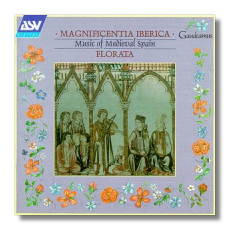
The Internet's Premier Classical Music Source
Related Links
- Latest Reviews
- More Reviews
-
By Composer
-
Collections
DVD & Blu-ray
Books
Concert Reviews
Articles/Interviews
Software
Audio
Search Amazon
Recommended Links
Site News
 CD Review
CD Review
Magnificentia Iberica

Music of Medieval Spain
- que faz os peccadores
- Splendens Ceptigera (Llibre Vermell)
- Com' A Grande Enfermidade (Cantiga #346)
- Miragres Fremosos (Estampie On Cantiga #37)
- Ben Pode Santa Maria (Cantiga #362)
- Annua Gaudia
- El Rey de Francia
- Des Oge Mais (Cantiga #1)
- Los Set Gotxs Recomptarem/Estampie On Los Set (Llibre Vermell)
- Nenbre Sse Te, Madre (Cantiga For The Feasts Of Mary #11)
- In Sapiencia Disponens
- Three Traditional Andalusian Melodies
- Inperayritz
- Tanto Son Da Groriosa (Cantiga #48)
Florata
Academy Sound & Vision Gaudeamus CDGAU144 DDD 67:11
Florata is the Ensemble-in-Residence at the University of Leeds, where they research and perform medieval European music. They are particularly interested in looking in the melting pot from that place and time, giving it a stir, and examining the cross-cultural influences that rise to the top.
"Magnificentia Iberica" is the result of such a stir. Medieval Spain was a cultural sponge, soaking up and squeezing out musical elements to and from Africa, the Middle East, and the rest of Europe. As a result, the variety of styles present on this CD is extremely rich. Sources include the Cantigas de Santa María (a collection of Castilian songs in praise of the Virgin, sung in a sensuous hybrid of Galician and Portuguese), the Llibre Vermell (pilgrims' songs originating from the mountains near Barcelona, and sung either in Latin or Catalan), the Codex Calixtinus and Las Huelgas Codex (mono- and polyphonic music, largely used in religious offices, that was written in Spain or in other parts of Europe), and music from the Sephardic Jews (which subsequently became, in large part, the music of several north African countries) and Moors (music associated with Arabia, and again, with North Africa). This variety explains why "Magnificentia Iberica" sounds like a flamenco dance one moment, and an belly dance the next (with a little "El Condor Pasa" thrown in for good luck).
Convention files CDs like this under "classical," but they fit just as sensibly under "folk." In the United States, the Baltimore Consort has been exploring the same dichotomy for several years. In fact, when Tim Rayborn and Nicholas Meredith sing together in "Ben Pode Santa María," one of the Cantigas de Santa María, they sound like a latter day Simon and Garfunkel. (That's intended as a compliment.) The members of Florata (Rachel Segal, Rebecca Davies, Tim Rayborn, and Nicholas Meredith) sing in a folksy and intimate style, and all except Segal also play instruments very well. Davies plays the recorder, Meredith the medieval fiddle and the rebec, and Rayborn the harp, percussion, ud (or "oud," a fretless lute) and psaltery. The use of instuments in the Cantigas is somewhat controversial; some groups have performed them unaccompanied. The accompaniments used here are derived from pictorial evidence and they contribute to the folksy quality.
Extremely well documented and presented, "Magnificentia Iberica" is a cozy treat, and one doesn't have to be a scholar of Early Music to enjoy it.
Copyright © 1996, Raymond Tuttle



















